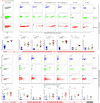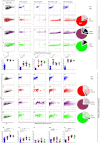Incunabular immunological events in prion trafficking
- PMID: 22679554
- PMCID: PMC3368226
- DOI: 10.1038/srep00440
Incunabular immunological events in prion trafficking
Abstract
While prions probably interact with the innate immune system immediately following infection, little is known about this initial confrontation. Here we investigated incunabular events in lymphotropic and intranodal prion trafficking by following highly enriched, fluorescent prions from infection sites to draining lymph nodes. We detected biphasic lymphotropic transport of prions from the initial entry site upon peripheral prion inoculation. Prions arrived in draining lymph nodes cell autonomously within two hours of intraperitoneal administration. Monocytes and dendritic cells (DCs) required Complement for optimal prion delivery to lymph nodes hours later in a second wave of prion trafficking. B cells constituted the majority of prion-bearing cells in the mediastinal lymph node by six hours, indicating intranodal prion reception from resident DCs or subcapsulary sinus macrophages or directly from follicular conduits. These data reveal novel, cell autonomous prion lymphotropism, and a prominent role for B cells in intranodal prion movement.
Figures








Similar articles
-
Monitoring immune cells trafficking fluorescent prion rods hours after intraperitoneal infection.J Vis Exp. 2010 Nov 19;(45):2349. doi: 10.3791/2349. J Vis Exp. 2010. PMID: 21113122 Free PMC article.
-
Complement Regulatory Protein Factor H Is a Soluble Prion Receptor That Potentiates Peripheral Prion Pathogenesis.J Immunol. 2017 Dec 1;199(11):3821-3827. doi: 10.4049/jimmunol.1701100. Epub 2017 Oct 25. J Immunol. 2017. PMID: 29070671 Free PMC article.
-
Peripheral prion disease pathogenesis is unaltered in the absence of sialoadhesin (Siglec-1/CD169).Immunology. 2014 Sep;143(1):120-9. doi: 10.1111/imm.12294. Immunology. 2014. PMID: 24684244 Free PMC article.
-
Cells and prions: a license to replicate.FEBS Lett. 2009 Aug 20;583(16):2674-84. doi: 10.1016/j.febslet.2009.06.014. Epub 2009 Jun 13. FEBS Lett. 2009. PMID: 19527722 Review.
-
Current concepts and controversies in prion immunopathology.J Mol Neurosci. 2004;23(1-2):3-12. doi: 10.1385/JMN:23:1-2:003. J Mol Neurosci. 2004. PMID: 15126687 Review.
Cited by
-
Emerging and Novel Functions of Complement Protein C1q.Front Immunol. 2015 Jun 29;6:317. doi: 10.3389/fimmu.2015.00317. eCollection 2015. Front Immunol. 2015. PMID: 26175731 Free PMC article. Review.
-
How do PrPSc Prions Spread between Host Species, and within Hosts?Pathogens. 2017 Nov 24;6(4):60. doi: 10.3390/pathogens6040060. Pathogens. 2017. PMID: 29186791 Free PMC article. Review.
-
Genetic depletion of complement receptors CD21/35 prevents terminal prion disease in a mouse model of chronic wasting disease.J Immunol. 2012 Nov 1;189(9):4520-7. doi: 10.4049/jimmunol.1201579. Epub 2012 Sep 21. J Immunol. 2012. PMID: 23002439 Free PMC article.
-
Oral Prion Disease Pathogenesis Is Impeded in the Specific Absence of CXCR5-Expressing Dendritic Cells.J Virol. 2017 Apr 28;91(10):e00124-17. doi: 10.1128/JVI.00124-17. Print 2017 May 15. J Virol. 2017. PMID: 28275192 Free PMC article.
-
Host prion protein expression levels impact prion tropism for the spleen.PLoS Pathog. 2020 Jul 23;16(7):e1008283. doi: 10.1371/journal.ppat.1008283. eCollection 2020 Jul. PLoS Pathog. 2020. PMID: 32702070 Free PMC article.
References
-
- Prusiner S. B. Novel proteinaceous infectious particles cause scrapie. Science 216, 136–144 (1982). - PubMed
-
- Büeler H. R. et al. Mice devoid of PrP are resistant to scrapie. Cell 73, 1339–1347 (1993). - PubMed
-
- Brown K. L. et al. Scrapie replication in lymphoid tissues depends on prion protein- expressing follicular dendritic cells. Nat Med 5, 1308–1312 (1999). - PubMed
-
- Montrasio F. et al. Impaired prion replication in spleens of mice lacking functional follicular dendritic cells. Science 288, 1257–1259 (2000). - PubMed
Publication types
MeSH terms
Substances
Grants and funding
LinkOut - more resources
Full Text Sources
Medical
Molecular Biology Databases

